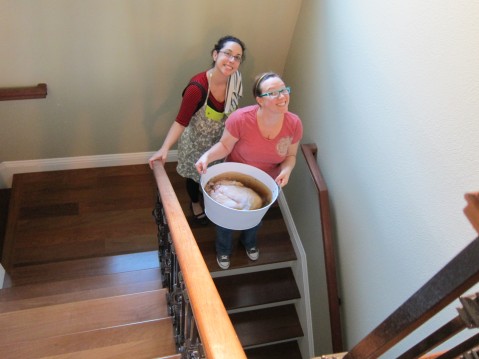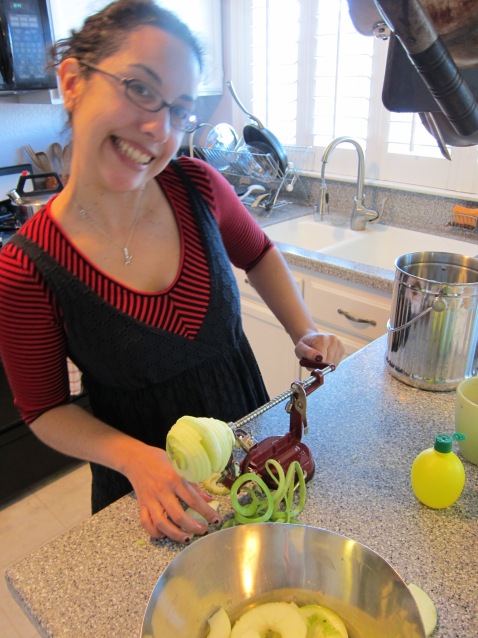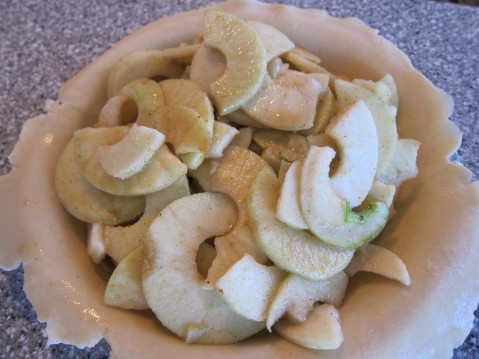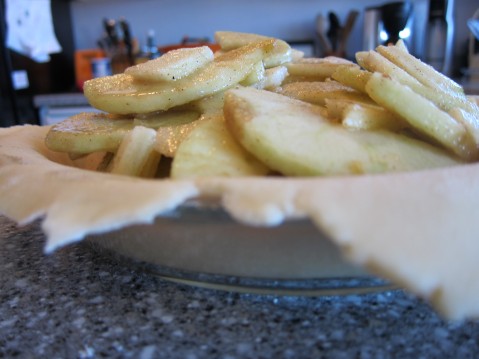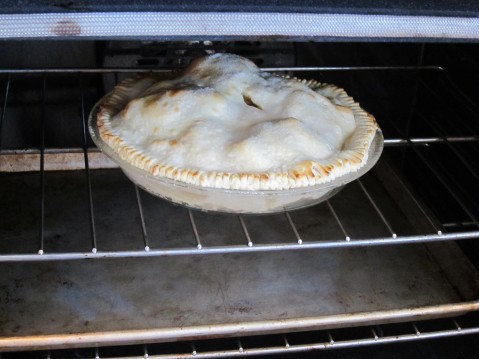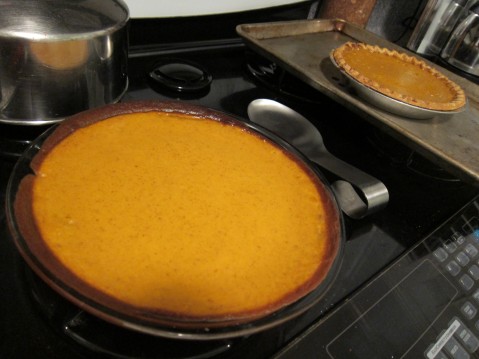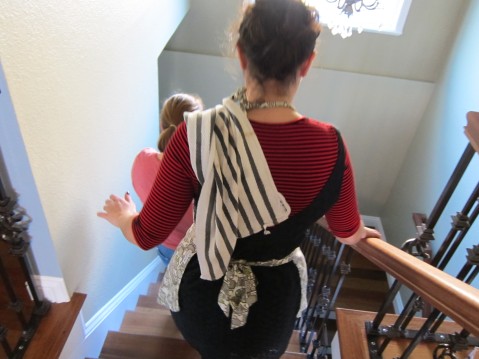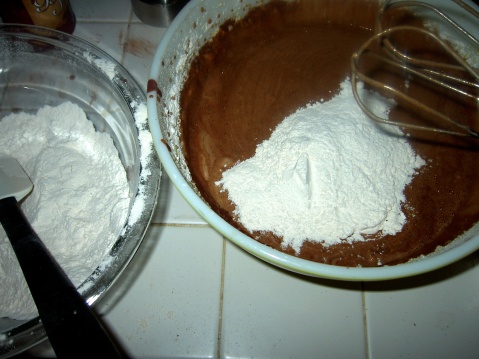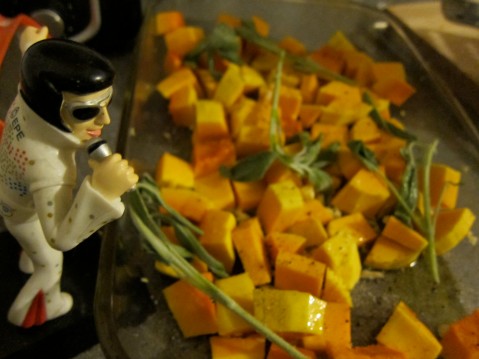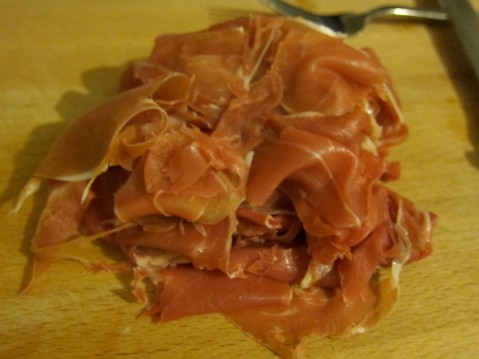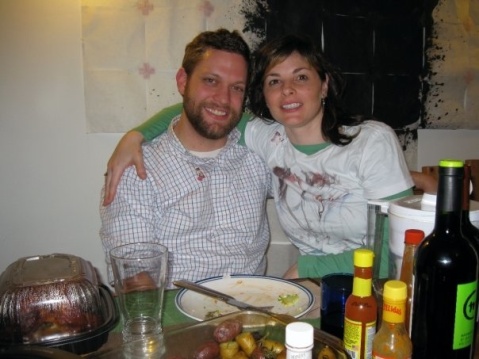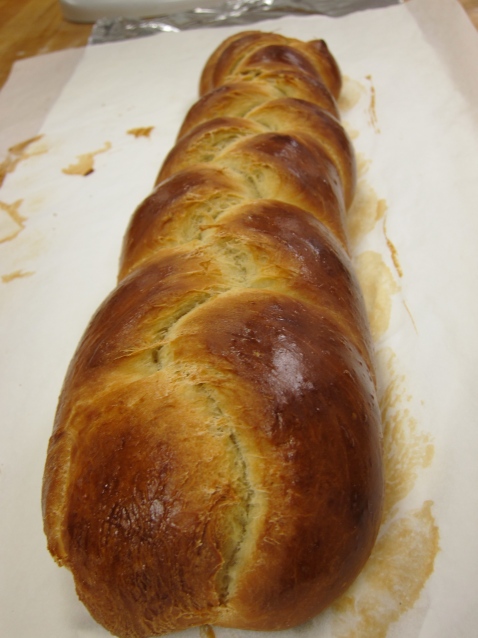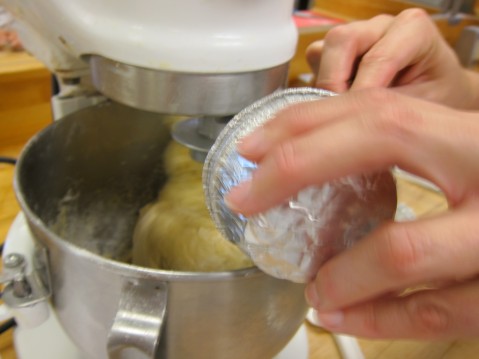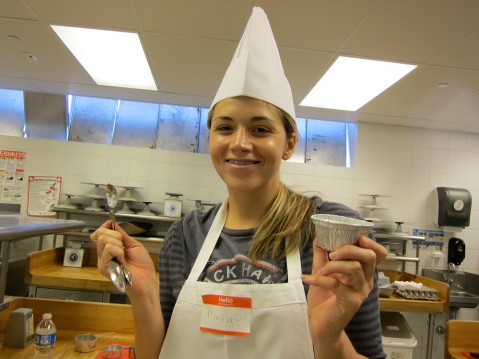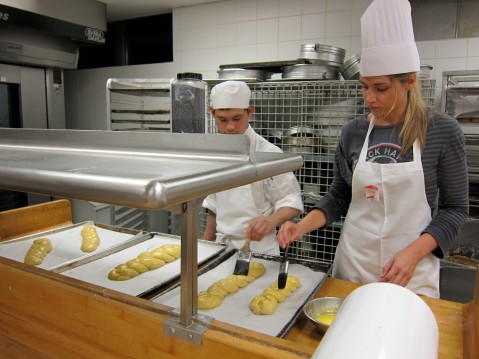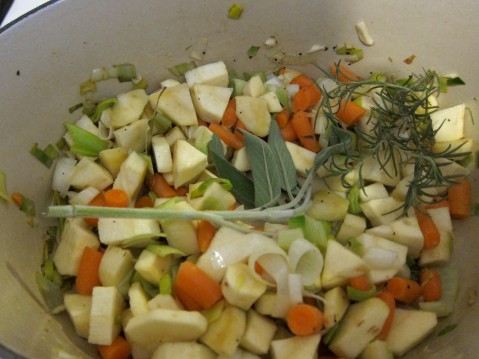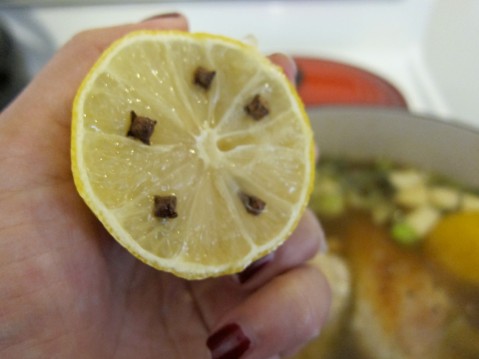Happy Thanksgiving! And Pie.
As onions saute in the kitchen and Tami sings along to Frosty the Snowman, I sit staring out a window that frames palm and cypress trees, layers of houses built into rising hills. I just got back from the beach. I’m south of San Francisco in a small coastal town aptly called Pacifica, with gloriously mild, sunny weather–not to mention babies, cats, friends, and delicious smells. I am thankful.
Christine and I went to a farmer’s market yesterday and then for an afternoon glass of wine at a small wine bar. Something about the way of interacting with the strangers we met, the casual California manner, made me so distinctly nostalgic for it. I am a Californian and can live anywhere, and can love many places, but something here connects to my synapses in a very visceral way. Doesn’t hurt that I’m surrounded by great people and sunshine and the ocean.
I think the thing I’m most thankful for is just capacity. The fact that I continue to be able to feel passionate about places and ideas, that I have so much love in my life. And that it doesn’t sort of ever reach its bottom.
We spent all day yesterday cooking, especially attending to the pie portion of the meal. Tami is a pie maven. She is known far and wide for these pies she makes, so naturally she lined up four for us to make for this extravagant meal. I’ve asked her to blog about them. And I’ve dubbed her the Pie-lette, for both her pie skills and her organizational (though not necessarily geographical) navigatory skills. Please note that, though she likes to make these pies, she does not like to eat pies. I dunno. Ask her.
The Pie-Lette:
Kate asked that I guest blog about my pie. Not a girl to turn down talking about my pie (nor to pass on an enjoyable double entendre), I naturally agreed. In anticipation of that great gluttonous celebration that is the giving of thanks, I baked four pies. For a dinner that will be attended by, at most, 6 adults and 2 toddlers. Most people view this as a very favorable pie:person ratio, made even more so by the fact that while I adore (baking) pie, I do not enjoy (eating) pie (usually).
My pie strategy is intricate. I spend months before gratitude-day reading about, and then test-baking pies. The menu is determined not as much by the size of the crowd (though certainly to an extent by the guests’ personal tastes and favorites), but by the success of my experiments. This year’s menu, the culmination of months of hard work and research, includes the following offerings: (1) Pumpkin Pie (x2, because we needed some pie after thinking about pie all day and could not possibly wait one whole other day for the consumption of pie), (2) Apple Pie (because people like apple pie), and (3) Pear Tart (because if anything is more fun than eating pie it’s eating a tart!)
The plan was to make first the apple pie, then the pumpkin, and finally the tart. But crust debacles intervened, and the tart decided to debut first. Hers is a simple crust, in a butter-rubbed dish, with pear halves dusted with cinnamon sugar on top. She’s lovely, and tasty, and an obviously rich addition to a day centered on giving thanks.
Pressed Pear Tart
from Real Simple
1/2 c. (1 stick) unsalted butter, plus more for the pan, at room temperature
1 c. all-purpose flour, plus more for your fingers
1/4 tsp. baking powder
1/2 c. sugar, plus 1 1/2 tablespoons
1 large egg
2 to 3 Bosc pears, peeled, halved, and cored
1 1/2 tsp. ground cinnamon
1/4 c. apricot jam
1 tbsp. fresh lemon juice
whipped cream (optional)
Directions
Heat oven to 350° F.
Butter a 14-inch rectangular tart pan and set aside.
Combine the flour and baking powder in a medium bowl and set aside.
Using an electric mixer, cream the butter and 1/2 cup sugar at high speed in a large bowl. Lower speed to medium, add the egg, and beat until incorporated. Gradually add the flour mixture until fully incorporated. The dough will be very soft.
Push the dough into the pan with floured fingers to form an even crust. Arrange the pear halves, top to bottom, cut-side down. Sprinkle with the cinnamon and the remaining sugar. Bake until the crust is golden brown, about 45 minutes; let cool.
Heat the apricot jam and lemon juice in a small saucepan over medium-low heat, mixing until combined. Remove from heat and brush gently over the entire tart. Serve with the whipped cream, if desired.
**** The Pie-Lette’s Apple Pie:
Next came the apple pie – a classic, deviation-free, retelling of Mark Bittman’s recipe. Being not in general a fan of pie (in this context), I especially abhor fruit pies. To me, they are like jello sandwiches. On Wonderbread. But, as with most food I cook, I bake apple pie to please others (most especially my father, an apple pie true believer). And this recipe, I have come to discover through years of reuse, is well-loved. I note also that this pie permitted us to introduce Kate to the apple corer-slicer-peeler that is pleasant on functional as well as aesthetic levels. She was appropriately enthusiastic.
¼ c. brown sugar
¼ c. white sugar, or more if you would like a very sweet pie, plus a little for the top of the pie
½ tsp. ground cinnamon
1/8 tsp. fresh grated nutmeg [I use jarred nutmeg, being obviously not as awesome as Mark Bittman]
Pinch salt
5 or 6 Cortland, McIntosh, or other good cooking applies [we used 4 large Granny Smith]
1 tsp. freshly squeezed lemon juice [I squeezed mine straight from the plastic lemon in my fridge; don’t tell]
1 ½ tsp. cornstarch or 2 tablespoons instant tapioca (optional) [I view tapioca flour as essential, and cornstarch unthinkable]
2 pie crusts
2 tbsp. unsalted butter, cut into bits
Milk as needed
Toss together the sugars, spices, and salt. Peel and core the apples and cut them into ½- to ¾-inch-thick slices. Toss the apples and lemon juice with the dry ingredients, adding the cornstarch or tapioca if you want a less runny pie.
Pile the apples into the rolled-out bottom crust, making the pile a little higher in the center than at the sides. Dot with butter. Cover with the top crust. Decorate the edges with a fork or your fingers. Refrigerate while you preheat the oven to 450 degrees Fahrenheit.
Place the pie on a cookie sheet and brush the top lightly with milk; sprinkle with sugar. Use a sharp paring knife to cut two or three 2-inch-long vent holes in the top crust; this will allow steam to escape. Place in the oven and bake for 10 minutes. Reduce the heat to 350 degrees Fahrenheit and bake for another 40 or 50 minutes, or until the pie is golden brown. Do not underbake. Cool on a rack before serving warm or at room temperature.
***Pumpkin Pie
And finally, after a turkey brining and cranberry relish crafting interlude, it was time to bake the pumpkin pie. Pumpkin pie is not an optional pie when it comes to Thanksgiving. It is the only sort of pie (well, not the only but among the few varietals) I am willing to eat. Again, I stick to tried and true Mark Bittman, though I have test-baked my way through dozens of recipes to determine that his is the best. I have used canned pumpkin and fresh, frozen crusts and scratch baked, all manner of spices and milks, and the below recipe provides the best spicy, sassy flavor and smooth, luscious texture. Mmmmmmpie.
Pie Crust
3 eggs
¾ c. sugar
½ tsp. ground cinnamon
1/8 tsp. freshly grated nutmeg [again, I used jarred nutmeg because we cannot all be Mr. Bittman]
½ tsp. ground ginger [which I omit as I am not a ginger fan]
Pinch ground cloves
Pinch salt
2 c. canned or fresh pumpkin puree or cooked [I used canned this time; I find the texture preferable to fresh]
2 c. half-and-half, light cream, or whole milk [I have tried all, and prefer half-and-half]
Prebake the crust [at 425 degrees Fahrenheit, for about 10 minutes or as long as it takes to finish the rest of the filling preparation.] When the crust is done, turn the oven down to 375 degrees Fahrenheit.
Beat the eggs with the sugar, then add the spices and salt. Stir in the pumpkin puree and then the half-and-half. While the crust is baking, warm this mixture in a medium saucepan over medium-low heat, stirring occasionally, until it is hot to the touch; do not boil.
Place the pie plate on a baking sheet. Pour this mixture into the still-hot crust and bake 30 to 40 minutes, until the mixture shakes like Jell-O but is still quite moist. Cool on a rack and serve warm or at room temperature.
The Baketrix: Chocolate Cupcakes with Cream Cheese Frosting
In honor of the birthdays of Matt (today) and my sister (last week)–two of my favorite people–I am posting the Baketrix’s scrumptious chocolate cupcake recipe. Matt was meh-ing around this morning about turning older and blah blah blah, and I just wanted to make it known that I, for one, am extremely grateful that the world begat both Matt and Tricia. I say, the occasions of their birth must be feted with chocolate!
The Baketrix:
Good things come in small packages…Cupcakes!!!!
The cupcake craze is still growing in popularity and more and more shops have popped up in Los Angeles–although it cannot compare with New York City. On a visit there, it seemed that there were cupcakes being sold on every corner. I think NYC should change from being referred to as the “big apple” to the “big cupcake!” But here in Los Angeles, one must seek out the cupcake, which often means getting into one’s car and driving.
I am fortunate that I live in Hollywood where there are at least six locations for cupcakes or other baked goodies within a three-mile radius. However, I am picky about my cupcakes–any baked goodie must be “worth the calories,” and some of the locations do not cut the mustard! My litmus test for any bakery is the red velvet cupcake–if a shop has a moist, tasty, and cream cheese–frosted one, it is worth going back to. None of this cream cheese with flour frosting that gives it a weird consistency! What’s up with that?
Unfortunately, my countless attempts to re-create the red velvet cupcake have been disappointing. I have given up on baking my own and will gladly hop in my car or my bike (but that makes transporting the cupcakes back a challenge) to Toast restaurant on Third Street, which has a good one. If I am really craving red velvet, by far my favorite is at Violet’s Cupcakes, which I discovered while working in Pasadena. Their cupcakes are total homestyle, hand-frosted (not put in a pastry bag with a decorating tip). The cupcakes are approachable, not fussy or pretentious.
But I stray…in place of baking my own red velvet cake, I default to chocolate cake. My partner Tom Clancey (not the writer/game developer but http://tomclancey.com/) baked an amazing cake one year for my birthday and it has become the “go-to” recipe. The cake is light and rich and well, decadent. And topped off with a cream cheese frosting, oooooohhhhh, so good!
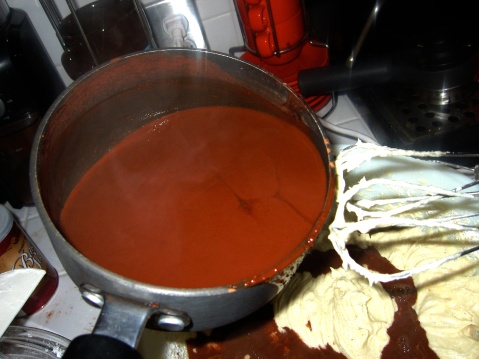
Black Pearl Layer Cake
from Bon Appetit, January 2005
Note: this is an amazing cake with exotic flavors, the filling is ganache with wasabi…for the cupcakes, I use only the cake recipe part. For the full recipe, please go to epicurious.com
This is for three layers of cake so it will make a LOT of cupcakes.
2 c. boiling water
1 c. unsweetened cocoa powder
2 3/4 c. all purpose flour (do not substitute with whole wheat flour)
2 tsp. baking soda
1/3 tsp. baking powder
1/2 tsp. salt
2 1/4 c. sugar (I use baking sugar)
1 c. (2 sticks) buttah, unsalted at room temp
4 large eggs
1 Tbs. vanilla extract
Preheat oven to 350 degrees.
Line or butter/flour cupcake pan.
Whisk 2 cups boiling water and cocoa powder in a bowl.
Whisk flour, baking soda, baking powder, and salt in large bowl (I combine all in a large sieve to add directly to the wet mixture to avoid dirtying another bowl–but I end up making a huge mess all over the counter, so you may want to use the separate bowl for dry ingredients!).
Using electric mixer, beat sugar and butter in a large bowl until light a fluffy, approx. 1 minute. Add eggs one a time, beating until incorporated after each addition. Beat in vanilla.
Add flour mixture in four additions alternately with cocoa mixture in three additions, beginning and ending with the flour mixture. Do NOT skip this part, very critical to the outcome of the cake.
Pour into the pan, put in the oven and bake…cool completely before frosting!
While baking, prepare the cream cheese frosting.
Cream Cheese Frosting
2 8 oz. boxes cream cheese, room temperature
1/2 c. (1 stick) unsalted buttah, room temp
1 tbsp. vanilla extract
2 1/2 c. powdered sugar
Using electric mixer, beat cream cheese and butter in bowl until smooth. Beat in vanilla then beat in powdered sugar until smooth and creamy. Sample as you go! and be sure to lick the electric mixer beaters…
Spread on a GENEROUS amount of the frosting goodness once the cupcakes are cool. No one likes a thin layer of icing! Don’t be stingy! Top off with sprinkles to bring a splash of joy into everyone’s life.
Gemelli with Butternut Squash and Prosciutto
The Midwest. Sometimes it still surprises me that I live here, a state my grandparents fled for the sunshine and mountains of Southern California when my mom was five. A city I’d never given much thought to when fantasizing about exotic backdrops for my life. But sometimes, somehow, I find myself in love with it, as I did today, driving through the hazy industrial cityscapes that girdle the freeway on my way into work. Each morning, I move through the knot of the Loop, its overly designed metal caverns, to the open eastward swatch of sea (can you call a lake a sea?), with the sun still lazing upward. The light was weak this morning and cast a peach haze, which, against the burnt reds and siennas that the leaves are wearing now, was lovely. Nearing campus, only a few miles from the Loop, I pass shingled craftsmen houses, runners, strollers, people waiting for the bus. It’s so quick to move from the overwrought to the provincial in this city. The strained and complicated city core gives way to the quieter rhythms of middle America. It’s an interesting metropolis.
All that is to say that landscape has always hit me heavily, and Chicago’s tends to offer an armature for the seasons, which drape themselves greedily over everything else. So, in a fall state of mind, I offer this recipe. Squash, prosciutto, toasted walnuts, sage, caramelized onions. The salty meat and nuts are great companions for the sweet squash and onions, and it all comes together in robust deliciousness. A dish to match windy fall nights in Chicago. Angela came over last week (or the week before?) and we concocted this based on ingredients we each had on hand. Then we drank much wine. Then we went out for more wine. Then I had to eat the leftovers for breakfast the next day to soak up all the wine.
Gemelli with Butternut Squash and Prosciutto
1 butternut squash, peeled, cored, and cut into chunks
4-5 sage leaves
4-5 garlic cloves, peeled and diced
nutmeg
salt and pepper
olive oil
1 lb. gemelli pasta (or alternative)
1 lb. prosciutto, diced into chunks
1 onion, peeled and sliced
1 c. walnuts, chopped
parmesan cheese
Preheat oven to 450 degrees.
In a baking dish, combine the squash, garlic, sage, grated nutmeg, salt, pepper, and oil. Pop in the oven for 25-30 minutes, until tender.
Coat a cast iron or heavy-bottomed pan with oil and a pat of butter. Turn the burner to low-medium, and add the onions. Slowly caramelize them until they are melty, golden, and putty in your hands. Set aside.
In the meantime, bring a pot of salted water to boil. Cook the pasta per the package.
Spread the walnuts on a baking sheet. During the last few minutes of the squash’s cooking, place the walnuts in the oven and toast until lightly browned and they have released their aroma.
Drain the pasta, reserving a bit of cooking liquid. In a large bowl, combine the pasta, onions, squash, prosciutto, and walnuts. Add a few tablespoons of the cooking liquid and oil as needed. Serve with parmesan cheese (and, if you feel adventurous, you could add goat cheese or gorgonzola).
Bread-O-Rama

I made this.
Last Sunday, I spent four hours in the kitchen of Kendall College, attempting to master the ancient art of bread baking. In a modern way, of course. There was an industrial mixer at each work station, giant multitiered commercial ovens, and the most fascinating device of all: a proofer, a sort of anti-refrigerator with controlled humidity and warmth for more rapid bread rising. I got to wear a chef’s hat.
Hardly ancient was our technique, but we were making one of the oldest and most fundamental food stuffs, dating back to at least the Neolithic period. As soon as humans figured out how to use things as tools, we must have been experimenting with things to smash, mix, and throw in the fire. The word we use comes from Old English, but it’s slang now for the thing most generally life-sustaining in the modern world. That is, money. Clearly our relationship to bread hasn’t changed much over time.
For something that’s been so fundamental to society, I knew hardly anything about making it before taking this class. I’d never even attempted it before, unless you count pizza dough (more on that experiment, still underway, in another post), which I don’t.
As we speak, I’m smearing goat cheese and avocado on a fluffy hunk of sourdough that I made myself. I’m not sure why this is so amazing to me, but there definitely is something about being able to make our most basic sustenance that makes me feel both very masterful, and completely humbled. As one of the very first food products in existence, it is still simple, delicious, perfect. Why aren’t we all making our own bread? If you’re going to cook, really, don’t you need to know how to master the foundations that cuisines–and cultures–have been built on for millennia? And what are the basic elements of cooking if not dough, sauce, protein, vegetable?
So, yeah, breadbaking class got me pretty excited.
We made four different kinds of bread, but I’ll start today with the challah.
Challah
4 to 4 1/2 c. bread flour, plus more for dusting
2 tsp. active dry yeast
1 c. room temperature water
3 eggs
2 egg yolks
1/4 c. olive oil, plus more for greasing
1/4 c. sugar
2 1/2 tsp. salt
Egg wash (1 egg whisked with 2 tbsp. cold milk)
poppy seeds are optional
Combine the flour and yeast in the bowl of a standing mixer with a a dough hook. Add water, eggs, egg yolks, oil, sugar, and salt, and mix on low for 4 minutes. Increase to medium speed and knead for 4 minutes. Dough should be soft but not sticky. Transfer dough to an oiled bowl, turn it over to coat with oil, cover with plastic wrap. Let rise until doubled in size, about an hour.
Place dough onto a lightly floured work surface and fold gently, cover, and let rest until relaxed (20 minutes). Divide dough into 3 equal pieces, cover and let rest for 20 minutes (we skipped this step in class).
Working with one piece at a time, gently stretch the dough to a 6 x 10 inch piece using only enough flour to keep dough from sticking (not too much). Fold dough into thirds (like an accordian) making a 2 x 10 inch piece.
Seal edges with the force of your palm, and repeat with all three pieces.
Roll each piece into a tapered cylinder that is 12 inches long. Lay the three ropes parallel to one another. Begin braiding in the center and work toward the outside. Pinch the ends together and tuck under. Place braid on a parchment-lined sheet pan.
Brush the braid lightly with egg wash and let rise, uncovered for one hour.
Preheat oven to 350 degrees. Gently brush with egg wash again (and sprinkle poppy seeds if desired). Bake until a deep, golden brown color appears and it is shiny and lightweight, about 25-30 minutes. Let cool before serving. If you can wait that long.
Chicken Orzo Soup
If ever there were a dish to invoke my internal grandmother, it’d be this one–a lemony, luscious chicken soup, with flavor packed into every single cubic inch. It puts my “I want to feed you” instinct into overdrive, makes me want to find someone who’s sick just so I can knock on his/her door with a bowl of this and some saltines. It’s so far removed from the salty Campbell’s version that you might not even know they were cousins. But they are! Kissing cousins. One of whom is just from the more sophisticated (and delicious) side of the family.
It makes a lot of soup–maybe 6 servings. But you should eat at least 2 bowls because you’re looking a little thin these days. And call your grandmother once in awhile, will ya?
Chicken Orzo Soup
2 bone-in chicken breasts
olive oil
salt
pepper
canola oil
2 leeks, cleaned and diced
4 garlic cloves, peeled and diced
2 parsnips, peeled and diced
2 large carrots, peeled and diced
1 bay leaf
3–4 sage leaves
3 sprigs rosemary
16 oz. veggie or chicken stock
4 cups water
1 lemon, cut in half and studded with cloves
1 c. orzo
Rub olive oil, salt, and pepper on both sides of the chicken breasts.
Heat canola oil (about 3 tbsp.) on high in a dutch oven. Get it really hot. When it’s releasing smoke and you can feel the heat with your hand hovering over it, add chicken, breast side down, and sear for 3 minutes. Flip and sear the other side for 3 minutes. Remove the chicken and lower the heat under the pot to medium. Add olive oil.
Add leeks, garlic, salt, and pepper, and sweat for 2 minutes. Add parsnips, carrots, bay leaf, rosemary, and sage. Cook for about 5 minutes, until the veggies glisten a bit from the oil and are somewhat softened.
Place the chicken back in the pot on the bed of veggies, and add the lemon studded with cloves. Cover with stock and water. Bring to a boil. Add orzo.
Reduce heat to simmer and cook until chicken is cooked through and veggies are soft, about 15 minutes.
Remove the chicken and remove its skin. With two forks, shred the chicken and add it back to the pot.
The Baketrix: Cornbread with Fennel Seeds, Cranberries, and Raisins
Halloween has passed and that means it’s officially time to start talking turkey. Mmmmmmmmmm turkey. The Baketrix here presents you with an idea for a lovely turkey side dish–a tangy, savory twist on traditional cornbread.
Also, I hope you have voted or will vote today!
The Baketrix:
Oh Corn, sweet corn…
I have a love/hate relationship with corn–or, rather, the manufacturers of corn by-products. As a testament to a shocking article in National Geographic that found that Americans have more corn genes in their blood stream than those living in Mexico where corn is the main staple, I am drawn to corn. Especially when I’m sick, I need me some comfort food, and all I want is a bowl of chicken matzo ball soup and a huge hunk of cornbread. I used to be fan of Marie Callendar’s cornbread for it’s cake-like texture, smothered in their famous honey butter. However, I have evolved in my cornbread repertoire and have found this amazing recipe for a sweet and full-flavored cornbread.
I found it one turkey holiday celebration when I was assigned with the gigantic task of supplying the cornbread. Now, this was a huge responsibility, and if I didn’t get it right, well–it meant the ruining of a time-honored tradition of cornbread and turkey (growing up the cornbread was replaced by Japanese short grain rice = yummy). I decided to cover my bases and baked a savory and sweet bread. Here’s the recipe I found and is now a favorite.

In addition to the ingredients, I often refer to this book my sister Sandy gave me when I first moved out of our parent’s house, the first move out of many as I was the total “boomerang kid!” “Where’s Mom Now that I Need Her? Surviving away from home” is my “go-to” book for information on substitutions, cooking tips and basic kitchen and home living skills! The book is welled loved and dog-eared and splattered with who knows what – thanks Sandy for the best house warming gift ever!
Corn Bread with Fennel Seeds, Dried Cranberries, and Golden Raisins
Adapted from Gourmet November 2001–I made slight changes in the mixing, so for unaltered recipe look for it online.
1 1/3 c. all-purpose flour (substitute white whole wheat for healthier choice)
2/3 c. yellow cornmeal (not coarse)
1/3 c. sugar (substitute evaporated cane sugar for healthier choice)
1 1/2 tsp. baking powder
3/4 tsp. baking soda
3/4 tsp. salt
1 1/2 sticks (3/4 c.) unsalted butter, melted and cooled
2 large eggs
1 1/2 c. well-shaken buttermilk (for the lactose intolerant, substitute with almond milk and add vinegar – for every 1/2 c. of buttermilk, use 1 1/2 tsp. distilled white vinegar)
1/2 c. golden raisins, coarsely chopped
1/2 c. dried cranberries, coarsely chopped
1 1/2 tbsp. fennel seeds, coarsely crushed with mortar and pestle or pulsed in an electric coffee/spice grinder (I ran out and tried substituting with caraway seeds, which gave it a more savory and less sweet flavor)
Preheat oven to 375 degrees.
Grease a square baking pan with butter and lightly coat with flour or cornmeal.
Whisk together butter, eggs and buttermilk in large bowl. Using a strainer, sift and stir together flour, cornmeal, sugar, baking power, baking soda, and salt. Add dry mix to the wet ingredients. Stir until just combined. Stir in raisins, cranberries and fennel seeds.
Pour into pan, bake until top is pale golden and tester comes out clean–I find 25-30 minutes to be the right amount in my oven. Cool on rack for 10 minutes then invert to cool completely…I usually can’t wait and just take a piping hot piece at that point! Someone’s got to test it to make sure it’s edible and can be shared with friends, right?!


